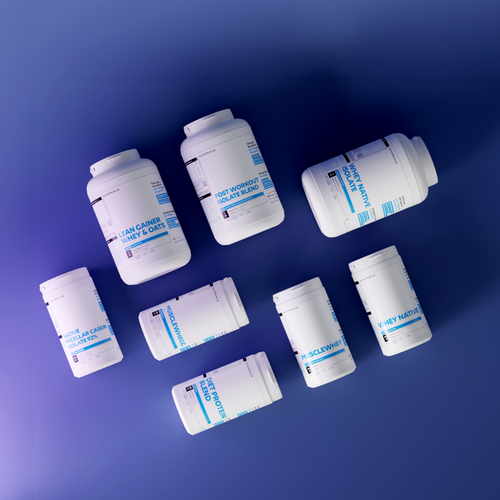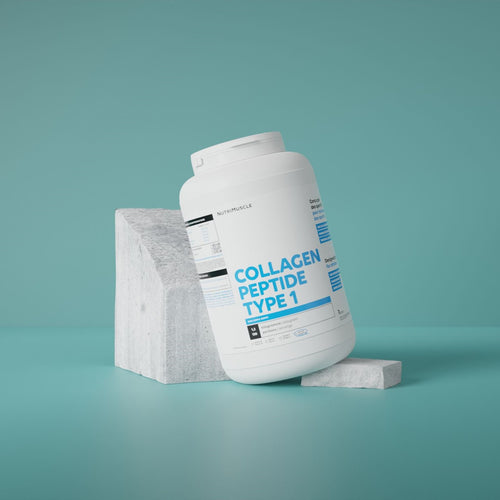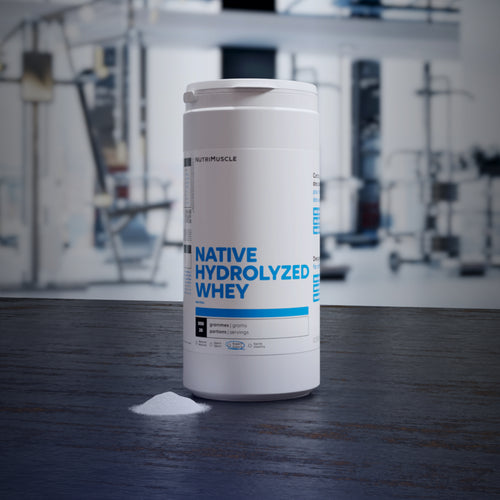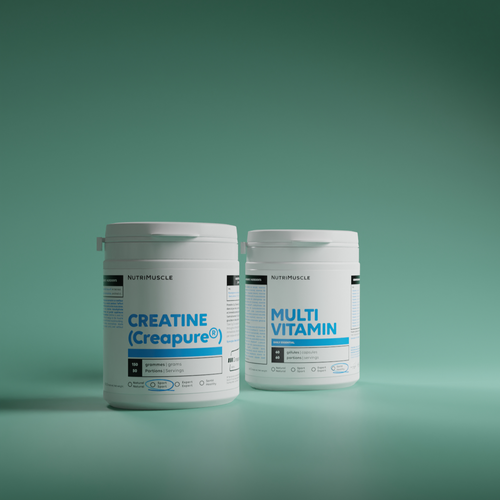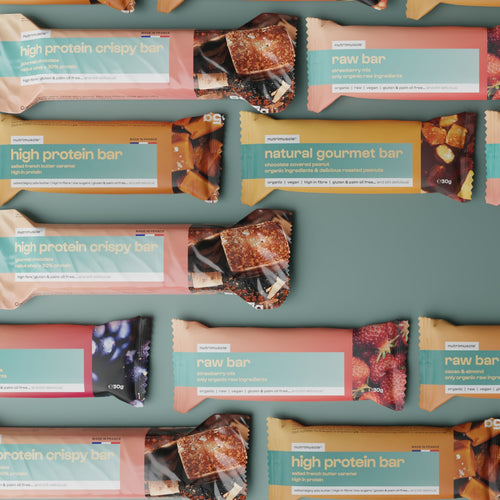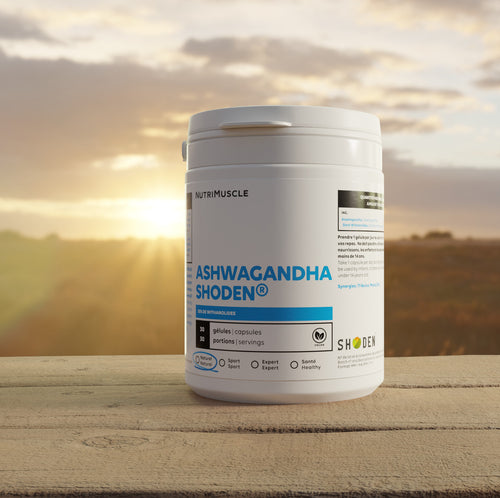0 commentaires
There are multiple products to maintain joint and tendon health. But what are they and how to choose the right product for your needs? Nutrimuscle explains everything there is to know about anti-inflammatories and the criteria to take into account when choosing the latter.
Contents
- Why protect your joints?
- The role of anti-inflammatory dietary supplements
- Anti-inflammatory dietary supplements
- How to choose the best anti-inflammatory?
- Preventive measures and complementary treatments
Why protect your joints?
Joint health becomes a concern when it begins to deteriorate. In other words, it is very often neglected. Ultimately, this negligence leads to pain related to age, physical exercise and can even aggravate minor injuries.
Protecting your joints is essential when practicing a sporting activity. Indeed, the main cause of a drop in performance or a cessation of sport remains the injury, or, to a lesser extent, the appearance of small pains preventing physical activity. It inevitably leads to abandonment and false beliefs, such as:
- "I'm too old now."
- "I'm not cut out for this sport."
- "It's too dangerous a sport."
However, good joint health makes it possible to practice physical exercise serenely and, therefore, to achieve one's goals more easily.
The role of anti-inflammatory dietary supplements
Joint, tendon and muscle pain are linked to a process of tissue inflammation. The purpose of anti-inflammatories in medicine is to block pain information. The symptoms go away, but the problem persists. This is why it is said that prevention is better than cure.
An anti-inflammatory food supplement provides the chemical elements necessary for healing. For example, with age, collagen stocks decrease which leads to friction between the joints and, by extension, pain. An anti-inflammatory (corticosteroid or non-steroidal type) blocks the sensation of pain for a limited time, while taking collagen reduces pain over the long term.
Too often neglected, supplements that provide protection and repair of tendons, joints and muscles are nevertheless the first supplements to favor when starting bodybuilding and sport in general.
In addition to its importance in sports, anti-inflammatories reduce the symptoms of joint diseases, such as osteoarthritis or arthritis.
Anti-inflammatory dietary supplements
There are several anti-inflammatory food supplements. Here are some examples :
Chondroitin
Chondroitin sulfate is a glycosaminoglycan, an important constituent of articular cartilage, tendons and skin (1-2) which is also found in type II peptan collagen.
It provides vital functions, especially for athletes by:
- Fighting against the degradation of cartilage cells (3-4);
- Exerting a naturally anti-inflammatory action (3-5-6);
- Fighting free radicals that attack our cells (7);
- Promoting tissue regeneration (8);
- Increasing the mechanical resistance to friction;
- Moisturizing and lubricating the joint (9);
- Ensuring its flexibility;
- Shock absorbing.
Chondroitin sulfate also produces indirect benefits on the joints. Indeed, it increases the activity of the enzymes responsible for the production of hyaluronic acid (a lubricant and anabolic food for the joints). (10).
By overstraining their muscles, the athlete accelerates the destruction of their joint hyaluronic acid. Athletes therefore have higher hyaluronic acid needs, needs that chondroitin sulphate helps to meet.
Chondroitin also promotes muscle growth. Indeed, in addition to its beneficial effects for joint health, hyaluronic acid also participates in muscle growth. (11).
Chondroitin doesn't just work on joints or muscles. It also helps to repair tendons by stimulating the local production of collagen. It is the latter that gives flexibility and resistance to the tendons.
Collagen type I and type II peptide
Collagen is the protein that provides joints, muscles and tendons with their cohesion, strength and elasticity. It is also he who is responsible for regenerating cartilage.
Collagen hydrolysates are successfully used against osteoarthritis (12-13-14-15-16-17-18-19).
Indeed, this degeneration is characterized by a decrease in the ability of the joints to produce collagen. Collagen hydrolysates are therefore ideal for combating this decrease in local cellular anabolism.
After muscular effort, the degradation of collagen in joints and tendons intensifies. The repair rate of tendon collagen is half that of muscle collagen (20).
The extracellular matrix that makes up the skin contains collagen and hyaluronic acid. It is 80% of type 1 collagen that is found in the skin. This collagen gives it firmness and suppleness.
Type II collagen is found very strongly localized in the bones and cartilages. It is therefore very interesting for people suffering from joint problems related to cartilage in particular.
At the skin level, taking Collagen Nutrimuscle orally provides collagen and increases hyaluronic acid synthesis, which helps the dermis to stay young, fighting against wrinkles and dryness (21).
Nutrimuscle Collagen Peptide Type I also promotes hair growth and healthy nails (22-23-24). It also inhibits bone loss, which preserves skeletal integrity (25).
N-Acetylglucosamine
Of all the glucosamines, only N-Acetylglucosamine is capable of accelerating cartilage anabolism, and therefore joint recovery (26-27-28) (29-30-31-32).
Research shows that N-Acetylglucosamine increases the rate of cartilage regeneration by 40%, while other glucosamines only slow anabolism (26).
Regular intake of glucosamine delays the progression of osteoarthritis. It also reduces the pain associated with it, while facilitating joint mobility (33).
Nutrimuscle N-Acetylglucosamine plays an important role not only in the joints. It also has vital functions for the skin. By ensuring elasticity and hydration, Nutrimuscle N-Acetylglucosamine acts as an anti-wrinkle agent, since the latter are due to the dryness of the skin and its lack of elasticity.
The reduction in the oily appearance of the skin as well as its better hydration suggests that N-Acetylglucosamine could also help cleanse the skin of its impurities and therefore fight acne. It can also help with healing, combat excessive flaking and sun damage to the skin (34-35-36-37).
wisteria
Glycine is a non-essential amino acid (38) which can however be lacking in athletes. Due to the omnipresence of this amino acid in the collagen of muscles, tendons, ligaments and skin, intense physical activity will increase our needs for glycine, without our intake increasing adequately without supplementation.
In collagen proteins, glycine makes up a quarter to a third of all amino acids (39).
It is therefore glycine which is the amino acid most present in this basic material for tendons, muscles, ligaments or skin.
In athletes, glycine deficiencies have been shown to be associated with a greater risk of injury than normal (40).
In endurance athletes, glycine supplementation protects the integrity of the athlete's health, particularly in the kidneys (41).
How to choose the best anti-inflammatory?
Several criteria must be taken into account when choosing your anti-inflammatory. Depending on the pathologies and sports needs, some food supplements will be more suitable than others.
Of the four joint protection supplements, Nutrimuscle Super Collagen Mix is the most universal, as it contains the amino acids that make up cartilage and tendons as well as glucosamine and chondroitin. Unlike other supplements, this collagen works on joints and tendons while N-Acetylglucosamine, chondroitin sulfate, and type II collagen essentially repair joints.
Glucosamine and chondroitin act in different and complementary ways on the joints. There is a synergy between these two joint protectors ; which explains why it is preferable to use them together rather than separately (42-43-44).
If you want to target the joints only, the ideal remains type II collagen as well as N-Acetylglucosamine, reinforced by chondroitin sulphate.
However, for total protection , it is preferable to combine collagen peptide type I + collagen peptide type II + N-Acetylglucosamine + chondroitin sulfate in order to act in depth both on the tendons as well as on the joints. It is, in this case, a coherent mixture operating in synergy.
Food allergy
For people with a shellfish allergy, collagen peptide type II or type I is ideal, because unlike glucosamine, it is not an extract of shellfish. The Super collagen mix can also be used without problems.
Preventive measures and complementary treatments
There are several ways to maintain joint health. These include low-intensity exercise, rest, and diet.
Studies have shown the importance of a balance between activity and rest to maintain healthy joints. Rest helps reduce stress and strain on the joints, helping to heal and prevent injury. However, prolonged rest can lead to muscle stiffness and weakness. It is therefore essential to maintain regular and appropriate physical activity.
Physical exercise plays a crucial role in maintaining joint health. Studies have shown that regular exercise strengthens the muscles that support joints, improves flexibility and mobility, and reduces the risk of developing joint diseases, including osteoarthritis. Low-impact activities, such as swimming, water aerobics, cycling and walking, are particularly recommended, as they strain the joints while limiting stress on them.
Osteopathy and physiotherapy are complementary approaches to preserving joint health. Osteopaths use gentle manual techniques to improve joint mobility, relieve pain and restore musculoskeletal balance.
Besides these approaches, maintaining a healthy weight preserves joint health. Studies have linked overweight, obesity and an increased risk of developing joint diseases, especially osteoarthritis. A balanced diet rich in joint-beneficial nutrients such as omega-3 fatty acids, antioxidants and collagen reduces the risk of developing joint disease.
Scientific references
(1) Henrotin Y. Chondroitin Sulfate in the Treatment of Osteoarthritis: From in Vitro Studies to Clinical Recommendations. Ther Adv Musculoskelet Dis. 2010 December; 2(6): 335–348.
(2) Werth BB.Ultraviolet irradiation induces the accumulation of chondroitin sulfate, but not other glycosaminoglycans, in human skin. PLoS One. 2011;6(8):e14830. Epub 2011 Aug 4
(3) Imada K. Anti-arthritic Action Mechanisms of Natural Chondroitin Sulfate in Human Articular Chondrocytes and Synovial Fibroblasts. Biological and Pharmaceutical Bulletin. Flight. 33 (2010) No. 3P 410-414.
(4) Martel-Pelletier J. Effects of chondroitin sulfate in the pathophysiology of the osteoarthritic joint: a narrative review. Osteoarthritis Cartilage. 2010 Jun;18 Suppl 1:S7-11.
(5) Lambert C. Characterization of synovial angiogenesis in osteoarthritis patients and its modulation by chondroitin sulfate. Arthritis Res Ther. 2012 Mar 12;14(2):R58.
(6) du Souich P. Immunomodulatory and anti-inflammatory effects of chondroitin sulphate. J Cell Mol Med. 2009 Aug;13(8A):1451-63.
(7) Egea J. Antioxidant, antiinflammatory and neuroprotective actions of chondroitin sulfate and proteoglycans. Osteoarthritis Cartilage. 2010 Jun;18 Suppl 1:S24-7.
(8) Chen WC. Effect of chondroitin sulphate C on the in vitro and in vivo chondrogenesis of mesenchymal stem cells in crosslinked type II collagen scaffolds. J Tissue Eng Regen Med. 2012 Mar 12. [Epub ahead of print]
(9) Katta J. Chondroitin sulphate: an effective joint lubricant? Osteoarthritis Cartilage. 2009 Aug;17(8):1001-8.
(10) David-Raoudi M. Chondroitin sulfate increases hyaluronan production by human synoviocytes through differential regulation of hyaluronan synthases: Role of p38 and Akt. Arthritis Rheum. 2009 Mar;60(3):760-7
(11) Calve S. Hyaluronic acid, HAS1, and HAS2 are significantly upregulated during muscle hypertrophy. Am J Physiol Cell Physiol September 1, 2012 vol. 303 no. 5C
(12) Adam, M. Therapie der Osteoarthrosis, Welche Wirkung haben Gelatinepraparate? Therapiewoche (1991) 41: 2456–2461.
(13) Seeligmuller, K. Dem Knorpel auf die Sprunge helfen. Therapiewoche (1993) 43: 1810–1813.
(14) Barnett, ML Treatment of rheumatoid arthritis with oral type II collagen. Arthritis & Rheumatism (1998) 41: 290–297.
(15) Trentham, DEEffects of oral administration of type II collagen on rheumatoid arthritis. Science (1993) 261: 1727–1730.
(16) Kalden, JR Oral collagen in the treatment of rheumatoid arthritis. Arthritis & Rheumatism (1998) 41: 191–194.
(17) Bello AE. Collagen hydrolyzate for the treatment of osteoarthritis and other joint disorders: a review of the literature. Current Medical Research and Opinion, 2006, Vol. 22, No. 11: Pages 2221-2232
(18) Benito-Ruiz P. A randomized controlled trial on the efficacy and safety of a food ingredient, collagen hydrolysate, for improving joint comfort. International Journal of Food Sciences and Nutrition, 2009, Vol. 60, No. s2: Pages 99-113
(19) McAlindon TE Change in knee osteoarthritis cartilage detected by delayed gadolinium enhanced magnetic resonance imaging following treatment with collagen hydrolysate: a pilot randomized controlled trial. Osteoarthritis and Cartilage. Volume 19, Issue 4, April 2011, Pages 399–405
(20) Miller BF. Coordinated collagen and muscle protein synthesis in human patella tendon and quadriceps muscle after exercise. J Physiol 567.3 (2005) pp 1021–1033 1021
(21) Zague V. A new view concerning the effects of collagen hydrolyzate intake on skin properties. Archives of Dermatological Research. October 2008, Volume 300, Issue 9, pp 479-483
(22) Brodie, JM (1984) Hair growth benefits from dietary cysteine-gelatin supplementation. J.Appl. Cosmetol. 2:15–27.
(23) Morganti, P. & Randazzo, SD (1984) Nutrition and hair. J.Appl. Cosmetol. 2:41–49.
(24) Gehring, W. (1992) Verbesserung der Nagelqualita¨ t durch Gelatine. Act. Dermatol. 18: 364–366.
(25) Moskowitz RW. Role of collagen hydrolyzate in bone and joint disease. Semin Arthritis Rheum. 2000 Oct;30(2):87-99.
(26) Uitterlinden EJ. Glucosamine reduces anabolic as well as catabolic processes in bovine chondrocytes cultured in alginate. Osteoarthritis Cartilage. 2007 Nov;15(11):1267-74.
(27) Shikhman A R. Chondroprotective activity of N-acetylglucosamine in rabbits with experimental osteoarthritis. Ann Rheum Dis 2005;64:89-94
(28) GREVENSTEIN J. Cartilage changes in rats induced by papain and the influence of treatment with N-acetylglucosamine. Acta orthopaedica belgica 1991, vol. 57, no2, pp. 157-161
(29) Talent JM. Pilot study of oral polymeric N-acetyl-D-glucosamine as a potential treatment for patients with osteoarthritis. Clin Ther. 1996 Nov-Dec;18(6):1184-90.
(30) Tamai Y. Enhanced healing of cartilage injuries by N-acetyl-d-glucosamine and glucuronic acid. Carbohydrate Polymers Volume 54, Issue 2, 1 November 2003, Pages 251–262
(31) Serpi M. Novel phosphoramidate prodrugs of N-acetyl-(D)-glucosamine with antidegenerative activity on bovine and human cartilage explants. J Med Chem. 2012 May 24;55(10):4629-39.
(32) McGuigan C. Phosphate prodrugs derived from N-acetylglucosamine have enhanced chondroprotective activity in explant cultures and represent a new lead in antiosteoarthritis drug discovery. J Med Chem. 2008 Sep 25;51(18):5807-12.
(33) Poolsup N., et al. Glucosamine long-term treatment and the progression of knee osteoarthritis: systematic review of randomized controlled trials. Ann Pharmacother. 2005 Jun; 39(6):1080-7.
(34) KIKUCHI K. Oral N-acetylglucosamine supplementation improves skin conditions of female volunteers: Clinical evaluation by a microscopic three-dimensional skin surface analyzer Journal of applied cosmetology 2002, vol. 20, no.2, pp. 143-152.
(35) Reyes E. Developments in photoaging: review of N-acetylglucosamine. Skin. 2011 (in press)
(36) Mammone T. The effect of N-acetyl-glucosamine on stratum corneum desquamation and water content in human skin. International Journal of Cosmetic Science. Volume 32, Issue 3, page 234, June 2010.
(37) Hwang YP. N-Acetylglucosamine suppress collagenase activation in ultraviolet B-irradiated human dermal fibroblasts: Involvement of calcium ions and mitogen-activated protein kinases. Journal of Dermatological Science Volume 63, Issue 2, August 2011, Pages 93–103.
(38) Wang W. Glycine metabolism in animals and humans: implications for nutrition and health. Amino Acids. 2013 Sep;45(3):463-77.
(39) Gannon MC. The metabolic response to ingested glycine. Am J Clin Nutr December 2002 vol. 76 no. 6 1302-1307
(40) van den Baar MT. Plasma amino acids and sports injuries. Amino Acids. 2004 Feb;26(1):71-6.
(41) Klause N. The use of glycine for nephroprotection in athletes taking part in endurance sports. Int J Sports Med. 1991 12: p123
(42) ZhangYX. Effects of chondroitin sulfate and glucosamine in adult patients with Kaschin-Beck disease. Clin Rheumatol. 2010 Apr;29(4):357-62.
(43) Tat SK. Chondroitin and glucosamine sulfate in combination decrease the pro-resorptive properties of human osteoarthritis subchondral bone osteoblasts: a basic science study. Arthritis Res Ther. 2007;9(6):R117.
(44) Lippiello L. Collagen Synthesis in tenocytes, ligament cells and chondrocytes exposed to a combination of Glucosamine HCl and chondroitin sulfate. Evid Based Complement Alternate Med. 2007 Jun;4(2):219-24.


